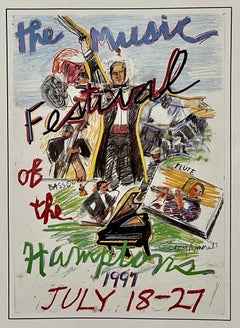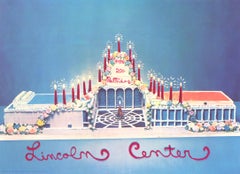Questions & Answers
Our trusted network of 1stDibs sellers answer common questions
What is the most famous piece of Pop art?
1 Answer
Opinions vary as to what the most famous piece of Pop art is. Two major contenders for the title are Andy Warhol's 1961–62 series Campbell's Soup Cans and Roy Lichtenstein's 1963 diptych painting Whaam!. Other notable Pop art works include A Bigger Splash by David Hockney, Flag by Jasper Johns, Crying Girl by Roy Lichtenstein, Radiant Baby by Keith Haring, the Marilyn Triptych by Andy Warhol, and Spoonbridge and Cherry by Claes Oldenburg. On 1stDibs, find a wide range of Pop art.
1stDibs ExpertApril 22, 2024
Related Questions
- Who is famous for creating Pop art?1 Answer
- What is the most famous piece of art in Paris?1 Answer
- What is Grayson Perry’s most famous piece of art?1 Answer
- What is Hundertwasser's most famous piece?1 Answer
- What is Banksy’s most famous piece?1 Answer
Shop for Larry Rivers Art on 1stDibs
Vintage Pop Art 1997 Offset Lithograph Larry Rivers Music Poster Hamptons NY
By Larry Rivers
Located in Surfside, FL
Larry Rivers
"The Music Festival of the Hamptons / July 18-27 1997" poster,
Not hand signed. [Dimensions: 24" H x 18" W]
Larry Rivers (born Yitzroch Loiza Grossberg) (1923 – 200...
Category
1990s Pop Art Abstract Prints
Materials
Lithograph, Offset
Untitled (Joe and Patsy LoGuidice at the Casa Luna)
By Larry Rivers
Located in Fairlawn, OH
Untitled (Joe and Patsy LoGuidice at the Casa Luna)
Pastel, charcoal and colored pencil on paper, 1970-1975
Signed lower right in pencil: Larry Rivers
Inscribed on the rabbit of the ...
Category
1970s Contemporary Figurative Drawings and Watercolors
Materials
Pastel
"L.C. 20th Anniv." by Larry Rivers (Graphic, Pop Art, Cake, Lincoln Center)
By Larry Rivers
Located in New York, NY
b. 1923, Bronx, NY – d. 2002, New York, NY
An artist, musician, filmmaker and occasional actor, Larry Rivers was best known as a revolutionary - deliberately opposing the prevailing...
Category
1970s Pop Art Figurative Prints
Materials
Lithograph
Larry Rivers Republique De Guinee Pochoir Inscribed in ink to Andy Warhol Framed
By Larry Rivers
Located in New York, NY
Larry Rivers
Republique De Guinee, for Andy Warhol, Inscribed in ink to Andy Warhol, 1977
Color Pochoir, Acrylic Airbrush and Pencil on paper with deckled edges
Hand signed and inscr...
Category
1970s Pop Art Figurative Prints
Materials
Mixed Media, Acrylic, Pencil, Stencil
"Hut can be a Hairdo" original lithograph
By Larry Rivers
Located in Henderson, NV
Medium: original lithograph. Printed in 1968 in psychedelic colors by Mourlot and published by Art In America. Size: 12 x 8 3/4 inches (302 x 225 mm). Signed in the plate, not hand-s...
Category
1960s Pop Art Prints and Multiples
Materials
Lithograph
Downtown Lion, Framed Pop Art Etching by Larry Rivers
By Larry Rivers
Located in Long Island City, NY
Artist: Larry Rivers, American (1923 - 2002)
Title: Downtown Lion
Year: 1967
Medium: Etching on Wove paper, signed and numbered in pencil
Edition: 3/24
Image Size: 11.5 x 17.5 inches...
Category
1960s Pop Art Animal Prints
Materials
Etching


